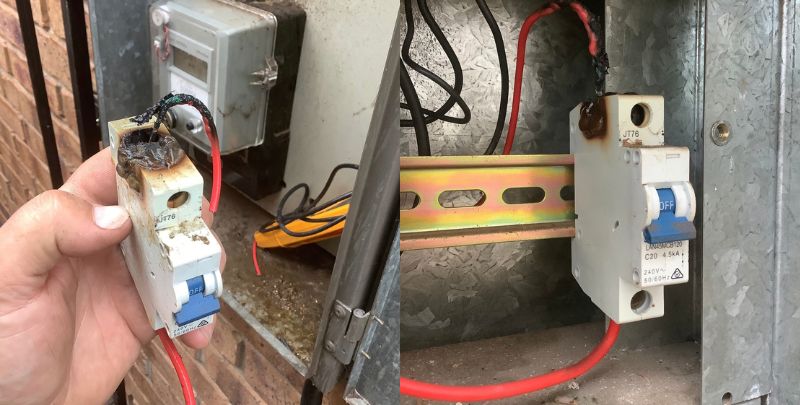
Electrical Safety at Home
Electricity. It’s an essential utility that most Australian homes cannot do without. It’s such an integral part of our daily lives, yet it can be easy to take for granted. That’s why so many Australians also forget just how dangerous electricity can be.
Electrical faults can result in electrical shock or fire; both with the potential to be fatal. The New South Wales Government reports that 40% of house fires in that state are the result of electrical faults. Something as simple as circuit breaker failure could prove deadly.
But with suitable safety measures in place, such as a working circuit breaker and an RCD (residual current device) safety switch, you can prevent the likelihood of an electrical hazard affecting your home or family.
It’s important though to ensure those safety measures are well maintained. They must remain capable of offering the protection and safety you need.
Let’s look at some of the most common issues caused by faulty circuit breakers, and how to fix them.
What is a Circuit Breaker?
A circuit breaker is a crucial element to any working home electrical wiring system. Its key function is to cut the power to your property when there is an excessively high current load. A current overload can cause your electrical wiring to overheat, which can lead to serious hazards such as electrical shock or fire.
Circuit breakers are found in your house’s electrical switchboard, which is usually in a box fixed to an easily accessible exterior wall of your home. Typical Australian homes will have a minimum of four or five on their switchboard. The individual breakers generally may include:
- General Purpose Output (GPO)
- Air conditioning
- Lights
- Oven
- Refrigerator
- Laundry
The switchboard also houses any safety switches as well as the main breaker switch that gives power to your property.
Short Circuits and Circuit Breakers
Circuit breakers also offer protection against electrical short circuits. A short circuit is when electrical current gets redirected from its expected path, usually to one that is shorter (hence its name). Short circuits are typically caused by one of three different issues:
- Faulty wiring insulation
- Faulty appliance wiring
- Wiring connections that have come loose
The most common form of short circuit is the “classic” type that likely comes to mind for most of us. This is caused by a ‘hot’ live wire coming into contact with a neutral wire. This results in a diminishing of the resistance, leading to a change of direction for the current.
The other type of short circuit is the Ground Fault, which occurs when contact is made between the grounded part of the wiring system and a hot wire that is bearing electrical current.
A short circuit is largely considered to be just as hazardous as an overloaded current, and can lead to a fire or electric shock.
What Happens When Circuit Breakers Trip?
When a circuit breaker detects a short circuit, or that there is an overload of current going through the system, it will trip and cut off the power. This commonly occurs when there are too many appliances plugged in your home at the same time.
You will see this by going to the switchboard and inspecting the circuit breaker switches. They have three positions; “on” (which is where they should be when everything is working OK), “off” and a centre position that the switch automatically flicks to when the circuit has tripped.
Unlike fuses in older homes, circuit breakers usually don’t need replacing. All you need to do is reset the switch on the circuit breaker panel. This is a relatively straightforward process; all you need to do is:
- Turn off and unplug the appliance you were using at the wall, as well as any other appliances likely connected to the individual circuit breaker
- Make sure that the switchboard box and the surrounding area (including the floor) are entirely dry before you come into contact with anything on the switchboard
- At least one switch will likely be in the centre position. Switch it to off, and then flip it back ‘on’
- If it has been successfully reset, it should remain on. Wait a few moments; if it doesn’t stay ‘on’ then you likely have a faulty circuit breaker
Substandard electrical wiring, whether it has succumbed to wear and tear or was just poorly installed, can be a common cause of faulty circuit breakers and should be tended to by a licensed electrician. There are numerous other signs to consider as well.

Most Common Signs of a Faulty Circuit Breaker
Most of us have, at one stage in our lives, have found ourselves in the middle of a task using an electrical appliance, only for the power to be cut. While it might seem mildly inconvenient at the time, it’s proof that the circuit breaker is actually doing its job.
Of course, if it continues to happen frequently, then your circuit breaker panel may actually be faulty and should be fixed as soon as possible to prevent any potential electrical hazards in your home. Among the numerous indications that there may be a fault are:
Your Lights are Flickering
Flickering lights can be highly distracting and can be caused by a range of issues including wiring that has overheated or connections that have come loose. However flickering lights can also be a sign of a greater fault at play. There may be an uneven flow of power, or certainly a faulty circuit breaker, which can and should therefore be assessed by a licensed electrical contractor.
You Notice a Burning Smell
If you notice a burning smell coming from the circuit breaker panel or near the switchboard, there is a strong possibility that it is failing to prevent the electrical circuits from overheating. If your electrical wiring and insulation gets too hot, it can burn and create a highly unpleasant smell. You may also notice burn marks on the panel or surrounding wall area. If you notice any of these, contact an electrician immediately.
The Circuit Breaker Keeps Tripping Unnecessarily
Sure, it’s highly beneficial to have a circuit breaker cut the power when you use a faulty power point or appliance. It means that it is doing its job and doing it effectively. It’s highly inconvenient though, when you’ve reset the switch and it keeps shutting off the electrical current for no clear reason. In this instance the problem is less likely to be with the appliance, and more with the breaker itself.
Home Appliances Don’t Work as Well as They Should
Found your vacuum cleaner or your toaster seemingly not working as well as it typically does? It might be a sign of a faulty circuit breaker, especially if the appliance itself has shown no signs of being faulty. They can lead to electrical wiring that overheats and causes issues with your home appliances.
If your home is 25 years old or over, you may still have an old fuse box system that quite likely won’t be able to offer the protection you need from electrical faults.
As consumer website Canstar recommends, upgrading to a modern system will significantly protect your home from electrical faults and short circuit issues. It will also protect you and your family against electric shock.
The Recap
Circuit breakers are essential for the protection of your family and home in the event of an electrical fault. Their basic function is to interrupt current flow when there is an overload or a short circuit by cutting off the power.
To make sure that they continue to protect people and property, it’s important to identify potential issues that might indicate a fault is present. These might include:
- Flickering lights
- Burning smell or signs of burning on switchboard or nearby wall
- The circuit breaker continues tripping frequently
- Appliances in the home do not work as well as normal
- The switches don’t want to reset
If you experience any of these problems, it is crucial that you contact a qualified electrician to inspect your electrical wiring and switchboard. If they identify any issues with your power or current flow, they can provide the necessary fix in the safest possible way.
When you need help with a faulty circuit breaker, don’t hesitate to contact the experts at Mr Emergency.
Please note: This information is provided for advice purposes only. Regulations differ from state to state, so please consult your local authorities or an industry professional before proceeding with any work. See our Terms & Conditions here.


